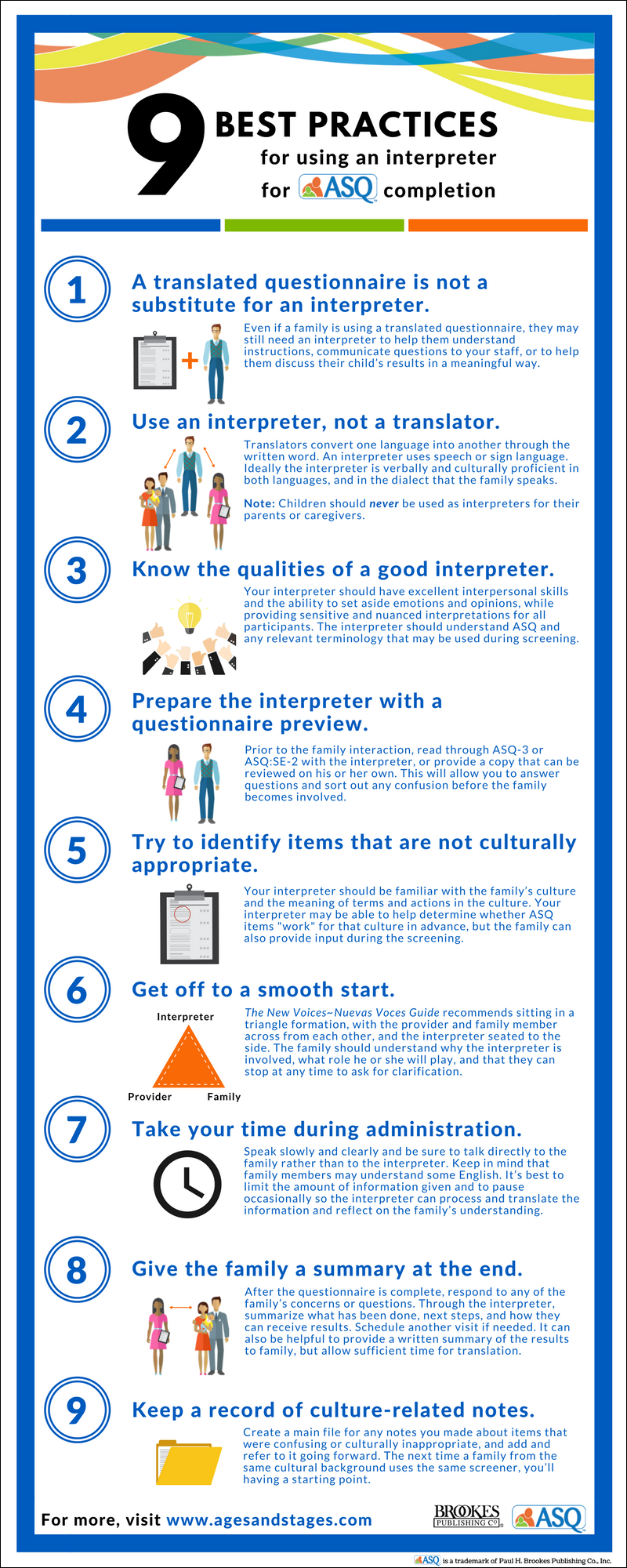9 best practices for using an interpreter for ASQ completion
Ensure the screening process goes smoothly, even when families speak a different language

As the U.S. becomes more and more ethnically diverse, it’s not uncommon to find children in early education programs who are first-generation English speakers. A language or major cultural difference between professionals and parents can impact everyday communication, but it can be especially challenging during the ASQ® screening process when face-to-face conversations may be pivotal.
If your program serves a diverse community, you can easily overcome any language barriers by using an interpreter.
Follow these 9 best practices for choosing and using an interpreter
With these simple tips, you’ll find that ASQ®-3 and ASQ®:SE-2 can be used successfully with families of all backgrounds.
1. A translated questionnaire is not a substitute for an interpreter.
|
Want a quick summary? |
|
Download the infographic!
|
Not all cultures rely on written communication in the way that the United States does. Even if a family is using a translated questionnaire, they may still need an interpreter to help them understand instructions, communicate questions to your staff, or to help them discuss their child’s results in a meaningful way.
2. Use an interpreter, not a translator.
Though often used interchangeably, interpreters and translators have very different skills and training. Translators convert one language into another through the written word. An interpreter uses speech or sign language. When attempting to overcome a language difference, it’s best to engage an interpreter.
Ideally this person is verbally and culturally proficient in both languages, and in the dialect that the family speaks. This will help the interpreter more accurately convey intended meaning and minimize miscommunications.
Note: Children should never be used as interpreters for their parents or caregivers.
3. Know the qualities of a good interpreter.
According to The New Voices~Nuevas Voces Guide to Cultural & Linguistic Diversity in Early Childhood, there is more to a good interpreter than being bilingual. In general, your interpreter should have excellent interpersonal skills and the ability to set aside emotions and opinions, while providing sensitive and nuanced interpretations for all participants.
The guide also recommends that when using an interpreter for the first time, professionals should be sure he or she understands the program (in this case, ASQ) and any relevant terminology that may be used during the interaction.
4. Prepare the interpreter with a questionnaire preview.
Prior to the family interaction, read through ASQ-3 or ASQ:SE-2 with the interpreter, or provide a copy that can be reviewed on his or her own. This will allow you to answer questions and sort out any confusion before the family becomes involved. If either you or the interpreter is unclear about the skill that is being measured by a particular item, discuss it with a child development expert to be sure the interpretation is accurate. You can also invite the interpreter to watch you administer ASQ with another family, with that family’s permission.
5. Try to identify items that are not culturally appropriate.
When working with families of different cultures, it’s important to consider whether ASQ items “work” for that culture. Your interpreter should be familiar with the family’s culture and the meaning of terms and actions in the culture. Your interpreter may be able to help with this exercise in advance, but the family can also provide input during the screening.
Discuss items of concern with a child development expert who is familiar with the culture and can help find a relevant substitute. Record the new item below the original and note the adaptation. Read more about screening children from diverse cultures, and get tips on creating substitute ASQ items.
6. Get off to a smooth start.
The New Voices~Nuevas Voces Guide recommends sitting in a triangle formation, with the provider and family member across from each other, and the interpreter seated to the side. The family should understand why the interpreter is involved, what role he or she will play, and that they can stop at any time to ask for clarification.
Once situated, introduce yourself through the interpreter. Explain the purpose of ASQ-3 or ASQ:SE-2, what the family can expect throughout the process, and that the screening is confidential.
7. Take your time during administration.
Speak slowly and clearly and be sure to talk directly to the family rather than to the interpreter. Keep in mind that family members may understand some English. It’s best to limit the amount of information given and to pause occasionally so the interpreter can process and translate the information and reflect on the family’s understanding.
Because some children feel more comfortable with their native language, encourage the family member and interpreter to help guide the child while he or she completes items. You can provide ideas and strategies to help them get involved.
Regularly check with the family to ensure items are culturally relevant. If someone expresses concern or confusion, make a note on that item.
8. Give the family a summary at the end.
After the questionnaire is complete, respond to any of the family’s concerns or questions. Through the interpreter, summarize what has been done, next steps, and how they can receive results. Schedule another visit if needed. It can also be helpful to provide a written summary of the results to family, but allow sufficient time for translation.
9. Keep a record of culture-related notes.
Create a main file for any notes you made about items that were confusing or culturally inappropriate, and add and refer to it going forward. The next time a family from the same cultural background uses the same screener, you’ll having a starting point.
Get tips for enhancing your program’s cultural awareness
There’s a lot that programs can do to better serve diverse communities beyond involving interpreters in the screening process. The ASQ developers recommend that practitioners meet internally to discuss cross-cultural considerations, and incorporate training activities to address issues that may arise when working with families of different cultures and languages.
For more information, download the authors’ Guidelines for Cultural and Linguistic Adaptation of ASQ-3 and ASQ:SE-2.
ASQ in additional languages
ASQ-3 is available for purchase in Arabic, Chinese, French, Spanish, and Vietnamese.
ASQ:SE-2 is available for purchase in French and Spanish.
Research versions of many other translations exist and pilot studies are ongoing. To inquire about obtaining access to the questionnaires in other languages, contact rights@brookespublishing.com.
Originally published: February 2016



